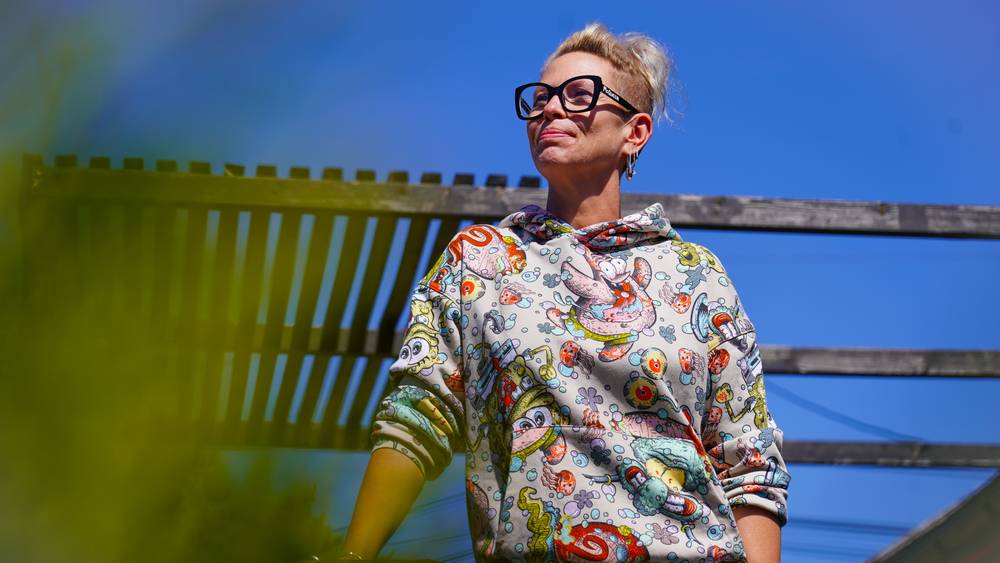– You’ll find a way to deal with it.
The year is 2007. During a busy workday, Ellen Knutsen suddenly feels intense pain – first in her back and then her leg gives way.
At the doctor’s office, she is told that she is pregnant and that pelvic joint pain is causing the discomfort.
Becoming a mother suddenly became an enormous strain.
– It was complicated. One should preferably not promise, and it is actually quite impossible to unngå.
Now, 18 years later, Ellen is still in pain.
– There can be two good weeks, two bad – two bad years, two good years. It goes up and down a lot.
WHEELCHAIR: Ellen has to alternate between standing, sitting, lying down and walking. On longer trips she often has to take her wheelchair with her.
– A little research
The mother of three suffers from pelvic joint pain, formerly known as pelvic luxation. The diagnosis affects approximately 12,000 Norwegian pregnant women a year. Researchers believe the old name is misleading.
– There is no evidence of a connection between a loose pelvis and pain.
That’s what Britt Stuge says. She works as a physiotherapist and researcher at Oslo University Hospital (OUS). She has a doctorate in pelvic joint pain and is also a specialist in women’s health.
Stuge says that 97 percent recover, but that the diagnosis varies.
Ellen is among the unfortunate 3 percent who have to live with chronic pain.
– It is a field that has been researched far too little, as is often the case with women’s health problems.
Physiotherapist and researcher, Britt Stuge, is one of Norway’s leading experts on pelvic joint pain.
Afraid of what people would think
Ellen has to alternate between lying down, sitting, walking, and standing to manage the pain she experiences during the day.
She is a “walking wheelchair user” – she likes to walk, but is dependent on having her wheelchair with her in case she gets pain or gets tired.
“walking wheelchair user”
– When I was about to start using a wheelchair, I had only seen people in wheelchairs all the time. When I tried it, I just got sicker.
Ellen usually walks when she is at home or going shopping at the local store.
She needed to figure out how to use the chair so that it worked for her.
At first, Ellen was afraid of what people would think when she got up from her chair.
– Look? Yes, at first I was very interested in it, but I’ve actually stopped doing that.
The fear of being stared at ended when she started a very special sport.
Ellen had “childfree” one summer and decided to go to an extreme sports festival.
Given a new perspective
– When I was sick, I spent a lot of time watching things on TV. I longed to make things up. And then there was Ekstremsportveko that I had watched on TV.
In 2015, she packed a tent and got in the car on the way to Voss.
It didn’t take long before she felt at home among the extreme sports athletes.
Ellen could be herself.
– There’s no one judging. They think it’s really cool if I get up and dance. And that I’m in, instead of not being in.
At Ekstremsportveko she became part of the longboard community. An environment she describes as inclusive and inspiring.
– You think so much about your own life, you are preoccupied with yourself and think that it is the most important thing in the whole world.
I got a different perspective where they risk their lives for something they are passionate about.
Ellen continued:
– Then I can get up from a wheelchair and sit down as I want. It’s so small in the grand scheme of things.
- Nadir Alam / NRK
«Nutz»
During competitions, everyone must wear a suit with protection. Ellen’s suit has “Nutz” written on the back. She got the nickname from the other athletes. It comes from her last name, which is Knutsen.
Nadir Alam / NRK
Nut helmet
She had the helmet specially designed. It is supposed to represent a nut with a squirrel clinging to it. She has also had her children’s names engraved on the helmet.
Extreme sports week
The wheelchair from Nav
Ellen decides to drive in the wheelchair she got from Nav. It is not designed for such high speeds, but it has been going well so far. It is only the tires that have become a little worn. Ellen has measured a top speed of over 55 kilometers per hour in the chair.
«Nutz»
During competitions, everyone must wear a suit with protection. Ellen’s suit has “Nutz” written on the back. She was given the nickname by the other athletes. It comes from her last name, which is Knutsen.
Nøttehjelm
She had the helmet specially designed. It is supposed to represent a nut with a squirrel clinging to it. She also had the names of her children engraved on the helmet.
The wheelchair from Nav
Ellen decides to drive in the wheelchair she got from Nav. It’s not designed for such high speeds, but it’s been going well so far. It’s just the tires that have gotten a little worn. Ellen has measured a top speed of over 55 kilometers per hour in the chair.
Ellen “Nutz” Knutsen
Now she competes to get down a winding road in a wheelchair as quickly as possible.
– I thought longboarding was really fun to watch, because I used to skateboard when I was younger, says Ellen.
Ellen drives down “Skjervet” in Voss at a speed of 55 km/h during the Extreme Sports Week. Photo: Sander Viste Medhus
You need javascript to view video.
Ellen drives down “Skjervet” in Voss at a speed of 55 km/h during the Extreme Sports Week. Photo: Sander Viste Medhus
Ho longing to try. And got testa to drive down the banks in a luge. She was once bewitched.
luge
After a while, she would rather drive in the wheelchair she got from Nav.
– You disappear a little in the bubble. I feel equal. I feel like an extreme sports athlete, even though I use a wheelchair. It’s absolutely fantastic.
People from the community praise Ellen for being involved.
– I think it’s incredibly cool. It just shows what you can achieve, even with different challenges in everyday life, says Einar Kvam, responsible for longboarding during Extreme Sports Week.
Kvam has longboarded himself and says that Ellen is in many ways a cornerstone in the longboard community.
Einar Kvam is responsible for the longboard competition and has been involved in the sport himself.
When Ellen asked them if they could compete in a wheelchair, they couldn’t say no.
– It’s absolutely crazy to watch. I don’t think I would have dared to drive up that hill in a wheelchair.
– Is it worth it
Ellen doesn’t deny that extreme sports are expensive. She is often off work for several days after competitions.
– It comes with a cost, but it’s worth it.
Britt Stuge emphasizes that it is not dangerous in terms of pelvic joint pain.
– We shouldn’t scare people from doing things, the researcher concludes.

